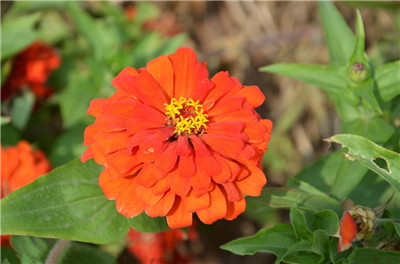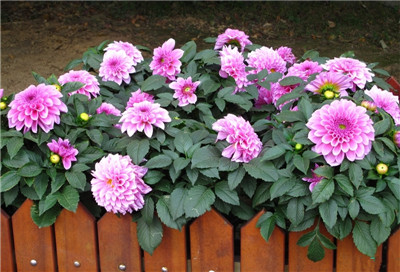How to breed hibiscus
The propagation methods of hibiscus include sowing, striping, cutting and dividing, but cutting propagation and split propagation are mainly used in production.
Cuttage propagation
Cuttings are easy to survive, and some even use long branches, but they must be buried at least 20 cm deep, otherwise they are easy to lodge or sprout and are vulnerable to drought because of shallow roots; like spring cuttings, they can bloom in summer and autumn.
Cutting time and method
After the local temperature has steadily passed 15 degrees Celsius, select 1-2-year-old strong and unsprouted branches (if the hibiscus branches sprout and grow leaves during cutting, the new leaves should be removed), cut the length of 15 cm to 20 cm, prepare a stick when cutting, insert a small hole in the seedbed according to the plant and row spacing, and then insert the hibiscus branches into the soil, compacting the soil, and penetrating the soil to a depth of 10 cm. That is to say, the depth of the cuttings should be up to 2GP3, and water should be filled immediately after insertion. There is no need to apply any base fertilizer when cutting. When indoor potted cuttings, choose 1-2-year-old strong branches with a length of about 10 cm, remove the lower leaves and cut off the upper leaves, cut them in a small bowl with coarse sand as the matrix, moisturize with plastic cover and maintain high humidity. Under the condition of 18-25 degrees Celsius, it can take root in about 20 days.
Cutting density
The density of seedling transplanting is different from that of direct transplanting. ① seedling transplanting method for easy operation, according to the border width 100cm, height 25cm to do the border, according to the plant, row spacing 15 × 30 cm planting; ② direct planting method can be according to the plant, row spacing 50 × 60 cm single row planting, can also be border planting, do 60 cm wide, 25 cm high border, in the border double lines are "product" shape planting, plant spacing 60 cm. In cultivation, we can make use of the flowering characteristics of cutting seedlings in the same year, cut according to the seedling transplanting density, and carry out inter-seedlings according to the fixed density before sprouting in spring every year 2 years later, so as to ensure that hibiscus hibiscus has enough nutritional space for the growth of that year, so as to increase the yield of fresh flowers.
Ramet propagation
Before sprouting in early spring, the adult plants with exuberant growth were dug up and planted according to the plant and row spacing of 50 × 60 cm with 3 main branches as a clump.

Hibiscus has strong adaptability and can grow in most parts of our country. Like the light and withstand the yin. Resistant to cold and afraid of drought. This also makes the cultivation method of hibiscus simple and has a strong ability to resist smoke and dust. Extensive management and proper watering. The propagation of hibiscus is mainly based on cuttage, which is easy to survive in spring or autumn. The soil can be covered to the base of the mother plant, let it branch, and then transplant the new branches with soil, the survival rate is very high. The cultivation method of hibiscus is simple and the management is quite easy. Fertilize once before sprouting in spring, and then prune it a little. Cold-resistant winter only needs to be kept at a very low temperature. Hibiscus symbolizes simplicity and tenacity, just like its life. At the same time, hibiscus is also the national flower of Korea. Propagation methods of hibiscus
The propagation methods of hibiscus include sowing, striping, cutting and splitting, but cutting propagation and split propagation are mainly used in production.
Cuttage propagation
Cuttings are easy to survive, some even use long branches, but the depth of the soil must at least reach 20cm, otherwise it is easy to lodge or sprout because of shallow roots and is vulnerable to drought; generally, cuttings in spring can blossom in summer and autumn.
Cutting time and method
After the local temperature has steadily passed 15 ℃, select 1-2-year-old strong and unsprouted branches (if the hibiscus branches sprout and grow leaves, the new leaves should be removed), cut into the 15~20cm segment, prepare a small stick when cutting, insert a small hole in the seedling bed according to the plant and row spacing, and then insert the hibiscus branches to compaction the soil and penetrate the depth of 10~15cm, that is, it is appropriate to cut into the depth of the cuttings. Fill with water immediately after insertion. There is no need to apply any base fertilizer when cutting. When indoor potted cutting, choose 1-2-year-old strong branches, grow about 10cm, remove the lower leaves, cut off half of the upper leaves, cuttage in a small bowl with coarse sand as the matrix, moisturize with plastic cover, maintain high humidity, under the condition of 18-25 ℃, it can take root in about 20 days.
Cutting density
The density of seedling transplanting is different from that of direct transplanting. In order to facilitate the operation, the ① seedling transplanting method makes the border according to the width 100cm and height 25cm of the border, and transplants according to the plant and row spacing of 15 × 30cm, while the ② direct transplanting method can be planted in a single row according to the plant and row spacing of 50 × 60cm, or the border can be made of wide 60cm and high 25cm, and the double rows on the border are in the shape of "product", and the plant spacing is 60cm. In cultivation, we can make use of the flowering characteristics of cutting seedlings in the same year, cut according to the seedling transplanting density, and carry on the seedlings according to a certain density before sprouting in spring every year after the second year, so as to ensure that hibiscus has enough nutrition space for the growth of that year, so as to increase the yield of fresh flowers.
Ramet propagation
Before sprouting in early spring, the adult plants with exuberant growth were dug up and planted with 3 main branches as a clump according to the plant and row spacing of 50 × 60cm.
- Prev

The sowing method of zinnia seed
The optimum temperature for seed germination is 20-25 degrees, germinates in 7-10 days, and blossoms about 70 days after sowing. 2-3 true leaves were transferred and 5 hearts were removed from 4mur. they could be colonized after 2 or 3 times of transplantation. In North China, more than half of April was sown in the open field, and about-week sprouted.
- Next

Propagation, cultivation and Management of Dahlia (Dahlia)
Dahlia (Dahlia) is native to Mexico. Mexicans regard it as a symbol of generosity and richness, so they respect it as the national flower. At present, it has been planted in most countries in the world, and new varieties have been selected from time to time. According to statistics, there are more than 30,000 dahlia varieties, which are the species with the largest number of flower varieties in the world.
Related
- Fuxing push coffee new agricultural production and marketing class: lack of small-scale processing plants
- Jujube rice field leisure farm deep ploughing Yilan for five years to create a space for organic food and play
- Nongyu Farm-A trial of organic papaya for brave women with advanced technology
- Four points for attention in the prevention and control of diseases and insect pests of edible fungi
- How to add nutrient solution to Edible Fungi
- Is there any good way to control edible fungus mites?
- Open Inoculation Technology of Edible Fungi
- Is there any clever way to use fertilizer for edible fungus in winter?
- What agents are used to kill the pathogens of edible fungi in the mushroom shed?
- Rapid drying of Edible Fungi

